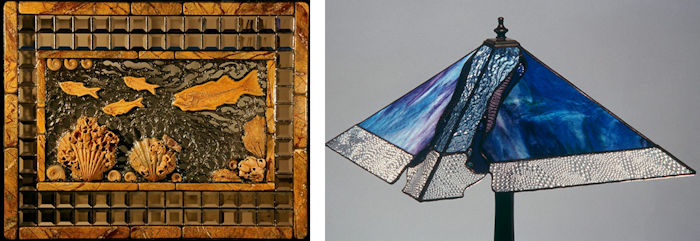It’s a Glass Act: Glass Blowing, Stained Glass and Kiln-Formed Glass
By Claire Larrabee
“Art glass” often evokes images of glass blowing with artisans bending over red-hot kilns to twist and shape molten lumps of glass into luminous, exotic forms. But glass blowers are not alone in their ability to create jaw-dropping works of art out of glass. Today, traditional glass blowers are joined by artists working with stained, fused, slumped, and cast glass that expand the artistic range of glass.
Looking at some of the imaginative work of glass artists who show with the Paradise City Arts Festivals got me wondering about different art glass techniques. Just how do these folks create the magic?
Some Like It Hot
Classic glass blowing is considered a “hot glass” technique. Makes sense, since glass blowers are working with glass at temperatures above 1000 °F! People have been working with this hot stuff since the middle of the 1st century BC, when glass workers discovered that a molten blob of glass would inflate by introducing a small amount of air into it.
There are two major glass blowing techniques – free-blowing and mold-blowing. Free-blowing was the original technique and is still widely used today. Glass workers blow puffs of air into the molten glass which is spooled at the end of a blowpipe. By rotating and swinging the pipe, and controlling the temperature, the glass blower can work the piece into the desired shape.
Mold-blowing got going about 50 years later. For this technique, the molten glass is inflated into a mold. It is the design on the interior of the mold that determines the shape and texture of the object.
Hot glass work by Danielle Blade and Stephen Gartner.
(Left to right: LED pendants, Opal with Sargasso Covered Tall Bowl with Bone & Tendril Finial, Amethyst & Sage Mini Arbors)
Whether free-blowing or mold-blowing, I think what modern glass blowers are doing is quite mind blowing. For example, Danielle Blade and Stephen Gartner use both traditional blown glass techniques and original sculpting techniques to produce intricate decorative and functional objects that combine multiple colors and textures in a single piece.
The Cool Kids
Stained glass is referred to as a “cold” glass technique, as the artist is not typically using heat to form the object. While not as old as glass blowing, stained glass has been around for more than a thousand years. Artists use glass that has been “stained” by the addition of metallic salts during its manufacture. After cutting the glass into the shapes needed to form the piece, the glass worker uses either traditional lead – or more commonly today, copper – to surround the edges of each piece and then solder them together.

Left to Right: Fossil Reef by Karen Hibbs, Stained Glass Lamp by Julia Brandis
Stained glass artists Karen Hibbs and Julia Brandis are pushing the boundaries of stained glass art today. Karen combines natural materials, like fossils and minerals, glass, metal, and even found objects to create panels of amazing texture and dimension. Julia Brandis uses varying glass textures and iridescence, wirework, and jewels to catch the light and create depth in her stained glass panels, lamps and fire screens.
Warming Up with Kiln-Formed Glass
I feel like Goldilocks trying out the three bears’ porridge – hot glass, cold glass and finally, the “warm glass” technique. This technique uses a kiln to heat the glass. It’s called “warm” because the artist does not typically work with the glass while it is hot.
Artists use a variety of processes with different kiln temperatures and times to produce specific effects in the glass. Fusing uses multiple pieces of glass that retain their shapes but become sticky so that adjacent pieces join together. Slumping deforms the shape of the glass so that it becomes flexible but still retains its approximate solid form. With casting, the glass actually melts, becoming a liquid that takes its shape from a mold.
Different fusing techniques by Michel L’Huillier.
(Left to Right: Fused glass plates, Fused panel from commissioned art work)
The work of fused glass artist Michel L’Huillier is a good example of the wide range of effects that can be achieved with fusing. His plates shown above fuse glass in precise, structured lines, while the fusing in the commissioned panel results in a flowing, water-like image.
Taking a different approach to using the kiln, Karen Gola concentrates on the cast glass technique, which she uses to mirror the soft, delicate colors of the ocean and the texture of time-washed sea glass.
Cast glass by Karen Gola
(Left to Right: Seagarden Collection, Seafoam Collection)
Glass Up Your Home this May at the Paradise City Arts Festival
Whether blown glass, stained glass, or kiln-formed glass tickles your fancy, you can find all of the exceptional glass artists featured here at the upcoming Paradise City Arts Festival, May 26, 27 and 28 at the Three County Fairgrounds, 54 Old Ferry Road, Northampton, MA. In addition, there will be many skilled artists working in all sorts of media who can help you glass up – or class up – your home. Click here for more information on the show, including hours, location, admission and exhibitors. Or, buy tickets here. Hope to see you there!


